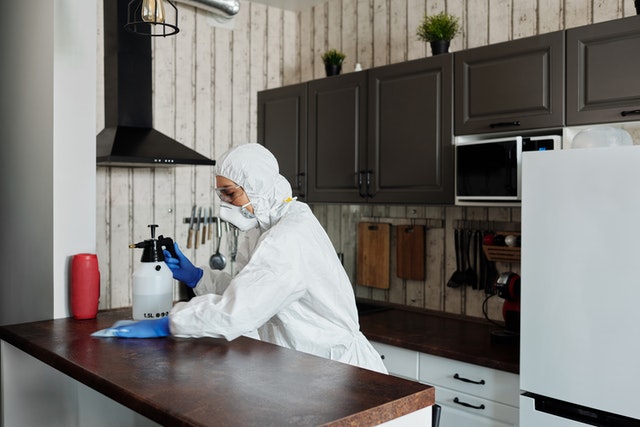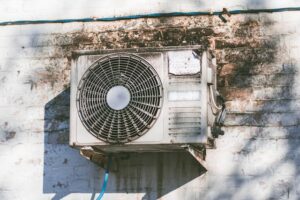Mould can look ugly and smell unpleasant, but it doesn’t have to ruin your home if you’re willing to get on your hands and knees with some mould killer and elbow grease. Follow these easy steps on how to remove mould from walls and ceilings, and you’ll be on your way to eliminating this pesky problem in no time. Make sure to wear gloves, goggles, and old clothes when working with bleach or any other harsh cleaning chemicals!
What Is Mould?
Mould is a fungus that feeds on organic material such as cellulose. You can find mould almost anywhere: in your yard, in your basement, inside your home—even on food. There are thousands of different types of mould, most of which you won’t recognize. Some types produce allergens and can even cause infections or diseases.
Good news: if you see or smell mould growth in your home, it’s usually easy to remove with basic cleaning tools and methods.
Bad news: removing mould isn’t always easy—and sometimes requires hiring a professional for removal and cleanup, so you don’t accidentally expose yourself to unhealthy mould spores or spread them around your home after they’re removed.
How can you tell if there is mould on your walls or ceilings?
Mould is a type of fungus that grows on the walls and ceilings of homes. It can be very hard to see and identify, so it is important to know how to tell if there is mould on your walls or ceilings.
There are some easy ways to tell if there is mould on your walls or ceilings. One way is by checking for a musty smell. If you notice the smell, there could be mould present somewhere in your home. Another way to check for mould is by looking for water stains in your walls or ceilings. If you find water stains, you should consider getting professional help as soon as possible because this could mean that there has been a leak in your wall or ceiling that has caused moisture and mould growth.
How does condensation cause mould growth?
Condensation is a form of water vapour in the air that forms when warm air cools down. It forms on cold surfaces such as windows, walls, or other objects. Condensation is also formed when water evaporates from wet surfaces and then turns into a gas. In most cases, condensation can be prevented by using a dehumidifier to remove excess moisture from the air.
Mould growth occurs when condensation takes place on a surface that has been moist for some time and there is an abundance of food particles and dead microscopic organisms on it. Condensation causes mould growth mainly because it creates an ideal environment for the growth of moulds.
Top Tips on How to Prevent Mold Growth in Your Home
Mould is a common problem that most homeowners face in their homes. It is important to know how to prevent mould growth in your home.
The best way to prevent mould growth in your home is by taking precautions and following the tips below.
1) Keep your home dry – Make sure that you do not let water accumulate on floors, walls, and ceilings. If you have a pool or spa, make sure it’s drained before storing furniture or other items near it.
2) Avoid humid environments – Reduce humidity levels in your house by using air conditioning or dehumidifiers when necessary.
What Caused Mould To Appear On Your Ceiling?
The most common cause of mould on your ceiling is inadequate ventilation in your home. Your home’s HVAC (heating, ventilation, and air conditioning) system draws air into it; that air needs somewhere to go. If you don’t have adequate ducting or vents that allow that warm, moist air to escape your house, it will stay in there.
How to Remove Mould from Ceiling?
Total Time: 30 minutes
Mould Removal with Bleach – Step 1
To use bleach, you will need a spray bottle that is capable of delivering a mist. Fill your spray bottle with 1 part bleach and 10 parts water. Mix well until all of the bleach has dissolved in water.
Mould Removal with Bleach – Step 2
Spray on surfaces with mould growth and let it sit for 15 minutes or more before wiping clean with a damp cloth. Make sure you do not rinse anything away because rinsing can spread mould spores throughout your home and cause even more damage than just letting it be.
Mould Removal with Vinegar – Step 1
Vinegar is a good choice for anyone looking for an organic solution. Add 1/2 cup of white vinegar to 1 gallon of water, mix well, and then pour into a spray bottle. Spray directly onto mouldy surfaces.
Mould Removal with Vinegar – Step 2
Wait 15 minutes, and then scrub clean with a brush or sponge. Use multiple applications if necessary for tougher stains. The smell of vinegar should disappear within two hours or less after application, but keep windows open or use fans in rooms that have been treated to remove any lingering odours. Do not use vinegar on marble, as it will etch your surface’s finish!
Dangers and Things to Avoid During Cleaning
Unless you have advanced training in remediation, it’s never a good idea to try removing mould on your own. The dangers include but are not limited to allergies, respiratory problems, worsening of pre-existing health conditions, lack of proper training that leads to serious damage. You must call professionals if you suspect any sign of mould growth. Their expertise could prevent major repair costs or structural damage down the road. If you don’t know who can help you with mould removal but suspect an issue, start with your local municipality (city hall). They will likely be able to point you in the right direction for remediation services.
Tips to Keep Your Ceiling Mould-Free
- You first want to remove any mouldy ceiling tiles, then wash them with mild soap or mould remover detergent. You can use a soft-bristled brush or another scrubbing tool, but be careful not to damage surrounding tiles with abrasive chemicals or materials—or you’ll have more problems on your hands!
- If using bleach mould killer or other strong cleaning agents, make sure you leave time for them to air out before turning your fans back on—leaving bleach-filled air in an enclosed space for too long can cause respiratory issues like coughing, sneezing, irritation of mucous membranes, runny nose and watering eyes.
FAQ Section:
How do you get rid of mould permanently?
Mold is a common indoor problem that can be difficult to get rid of permanently. The best way to get rid of mould is by using a vacuum cleaner.
Mold may be present in your home and you might not even know it. It can be found behind walls, in the floor, and even on your ceiling. It can also grow into an all-consuming infestation if it isn’t removed quickly.
If you think you have mold growing in your home, call a professional for help.
What is the best mould killer?
The best mould killer is one that you can use again and again. It should be easy to use and not require a lot of effort.
Crown moulding is a perfect example of this. You can easily reach the top of the crown moulding with a brush, spray or cloth and apply the treatment without having to climb onto ladders or scaffolding.
How do you remove mould from ceiling before painting?
You need to remove the mould from the ceiling before you can paint. There are two ways to do this: using a vacuum cleaner or a paint scraper.
To remove mould from the ceiling, you need to use a vacuum cleaner. The vacuum cleaner should be able to reach all corners of the room and be strong enough to suck up the mould. If it’s not strong enough, you can use a paint scraper instead.
How do I stop mould coming back on my ceiling?
Mould is a type of fungus that can grow on a variety of surfaces. It can be found on the inside and outside of your home, as well as in your garden and workplace.
The best way to prevent mould from growing is to have a clean surface. If you are unsure how to keep your home or workplace mould free, you should hire a professional who will use their expertise to help you with this problem.
If you are unable to find someone who will help remove the mould for you, there are some steps that you can take yourself that may help stop it coming back again. These include:
– Vacuuming up any debris
– Wiping down surfaces with bleach
– Spraying down surfaces with vinegar
How do I stop mould in my bedroom?
The most common reason for this problem is moisture. If you have a leaky roof, pipes, or chimney, water can get into your home and cause mould growth.
The best way to prevent mould in your bedroom is to keep it dry by using a dehumidifier and minimizing the amount of moisture in the air. You should also keep all cracks in the walls and windows closed so that air doesn’t get inside.
How do I stop mould on my bathroom ceiling?
There are a few ways you can do this, including using a fan or humidifier to keep the air moist and the humidity low, using an anti-mould spray, or using a dehumidifier.
The most effective way to remove mould from your bathroom is by cleaning it with bleach.
Why does mould keep coming back?
Some people might think that mould is a natural part of the home, but it can be very damaging. The most common ways that mould can spread are through the air, water or food.
Mould has a wide range of health effects and it can be extremely difficult to remove. It is important to prevent mould from spreading and keep your home clean so that you don’t have to deal with this problem again.
Some of the most common causes of mould in homes are:
– Poor ventilation
– Clogged drains
– High humidity levels
Can I paint over mould?
Painting over mould is not recommended. It can cause the mould to spread.
If you have a large area of mould, it will take a long time to replace and remove it all.
Does heating prevent mould?
The answer to the question, ‘Does heating prevent mould?’ is a resounding yes.
Mould is a type of fungus and it thrives in moist conditions. The moisture can come from water, condensation and even from humid air. If you have a damp or wet basement, the mould will be present there.
The most common types of mould are black and green, but they can also be red or blue. There are many different types of mould that exist in different environments such as on walls and floors as well as on furniture.
Does opening windows reduce mould?
Mould is a type of fungus that occurs when organic matter in the air and on surfaces starts to rot. It can cause damage to buildings, clothing, furniture and other materials.
Studies have shown that opening windows can reduce the amount of mould in a home. This is because the temperature inside a building is usually higher than outside, which means that air inside gets dryer faster than outside air. This drier air contains less water vapour, which mould needs to grow.
Is white vinegar good for removing mould?
White vinegar can be used to remove mould from surfaces and objects. It could also be used in the kitchen as a replacement for other cleaners.
White vinegar is a popular household cleaner. White vinegar is often used as a substitute for bleach, which can cause damage to clothing, fabrics, and wood furniture.
White vinegar is an effective cleaner that can easily remove mould and mildew from hard surfaces such as countertops, tiles, and floors. It is also safe to use on carpets and curtains that have been affected by mould or mildew growth.




